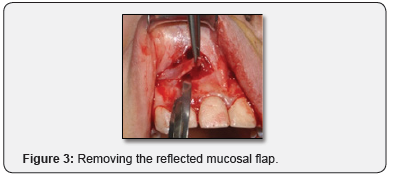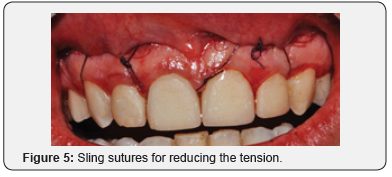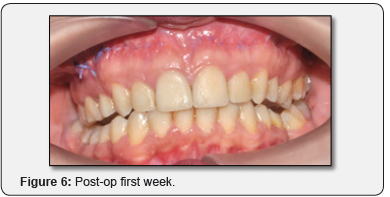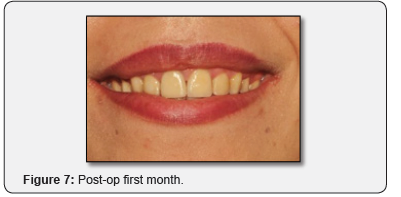Juniper Publishers- Open Access Journal of Case Studies
The Treatment of a Gummy Smile Patient with Laminate Veneers by Reverse Vestibuloplasty: A Case Study
Authored by Mustafa Özay Uslu
Abstract
Aesthetically desirable smiles demonstrate a gingival appearance of up to 3mm. Gummy smile is a clinical condition with gingival display more than 3mm which is often unpleasant for the individual. Reverse vestibuloplasty is a traditional surgical approach for the treatment of excessive gingival appearance by repositioning downward of the lips. Reverse vestibuloplasty offers a easy approach for the correction of gummy smile. In this case report, the treatment of gummy smile with reverse vestibuloplasty operation in a female patient with abnormal gingival view, was presented. A systemically healthy female patient was admitted to our clinic with an unesthetic appearance of gingival tissue with anterior teeth. Reverse vestibuloplasty surgery was planned. A two parallel horizontal incisions was made after local anesthesia at the mucogingival junction to alveolar mucosa on the lip, extend from right first molar to the left first molar tooth and the distal parts of incisions was merged. Sharp tissue dissection was made and the tissue was removed. Two horizontal incision lines were connected using simple suttures. The sutures removed after one week. Clinical records was collected at first week, one month and six month later. No complications and no scar were observed after operation. The healing was uneventful. High-level patient satisfaction was achieved.
Keywords:Reverse vestibuloplasty; Gummy smile; Aesthetic periodontal surgery
Introduction
Pleasant smile is the most important part of the beauty of facial aesthetics [1]. The condition of the oral tissues, the gingival outlines, the position of the lips and the symmetry of the teeth form appearing the basis of an aesthetic smile [2]. Ideal smile line is associated with the appearance of 1-2mm of gingival tissue with all coronal part of teeth [3]. A gummy smile usually appears when gingival visibility is greater than 3mm [4]. Gummy smile is more common in women. In addition, it has been reported that the grade of the gummy smile reduced with age due to decreased muscle tone in the lower and upper lips [5].
Gummy smile is associated with different etiologies. For this reason, it is necessary for the researcher to assess the patient’s smile design and to regard the relationship between the patient’s teeth, gingiva and lips in a smiling state. Depending on the etiology of the gummy smile treatment methods are crown lenghtening procedures, botulinum toxin injections, intrusion, orthognatic surgeries and reverse vestibuloplasty operation [6-8]. Reverse vestibuloplasty include the removal of a band of maxillary buccal mucosa and subsequently suturing the lip mucosa to the newly formed mucogingival line. The purpose of this approach is to reduce the retraction of the elevator smile muscles (e.g. levator anguli, levator labii superioris, zygomaticus minör and orbicularis oris).
In this case report we aimed to present the outcomes of a gummy smile treatment with reverse vestibuloplasty.
Case Report
Systematically healthy 30 years old female patient was admitted with a chief complaint of an abnormal excessive appearance more than 5mm of gingival tissues at anterior teeth (Figure 1). Reverse vestibuloplasty surgery was chosen instead of crown lenghtening procedure because of prosthetic laminate veneers.

A two parallel horizontal incisions was made after local anesthesia at the mucogingival junction to alveolar mucosa on the lip, extend from right first molar to the left first molar tooth and the distal parts of incisions was merged (Figure 2). Sharp dissection was made by scalpel and the reflected half-thickness flap between two incisions was removed (Figure 3).


Incision lines of newly formed shortened alveolar mucosa, were connected together with simple sutures (6-0 polyglycolideco- lactide, PGLA, Pegelak, Doğsan) and the tension was eliminated by sling sutures (3-0 PGLA, Doğsan) (Figure 4 & 5). The surgical area was covered by periodontal dressing (Coepak, GC).


Analgesic and chlorhexidine gluconate mouthrinse was prescribed and a post-op regimen was given. The sutures removed after one week. Clinical parameters was evaulated at 1st week, 1st and 6th month later (Figure 6-8).



No complications and no scar were observed after surgical operation. The healing was uneventful. The patient recruited an aesthetic smile and there was no relaps.
Discussion
Excessive gingival appearance known as gummy smile is an aesthetic problem in smile line [3]. Gingivoplasty is usually performed for aesthetic and functional purposes, to increase the crown lengths in the correction of the gummy smile. However, botulinium toxin injections, orthognathic surgical interventions and reverse vestibuloplasty, are among the other treatment options when gingivoplasty is not sufficient [9].
When performing a reverse vestibuloplasty, attention should be paid to surrounding anatomical formations and damage should be avoided. Suturing procedures should be done considering the attached gingiva borderline. If attached gingiva aren’t sufficient, flap design, suturing and stabilization are difficulty. Patients with severe skeletal deformities, reverse vestibuloplasty is contraindicated and orthognathic surgery should be considered [7].
Conclusion
In this case, it was showned that the treatment of some suitable gummy smile cases with reverse vestibuloplasty was very effective treatment modality of and provides stable results.
For more articles in Open Access Journal of Case Studies please click on: https://juniperpublishers.com/jojcs/index.php




No comments:
Post a Comment